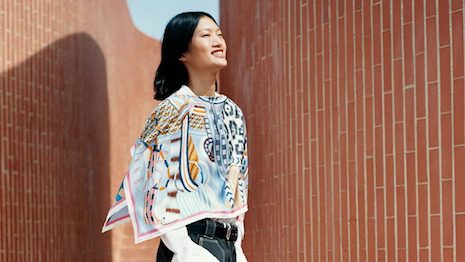By Kevin Rozario
There have been conflicting reports about China’s luxury prospects in recent weeks. Either they were heralding a major correction for spending, or that demand was on its way back. In fact, both are on the cards.
Sharply-rising COVID cases from mid-March had started to negatively impact first-quarter results from the likes of Hermès, LVMH and Kering, but the lifting of strict city lockdowns means that spending appetites should return.
The full force of Beijing’s tough health restrictions will hit luxury houses in the quarter ending June.
As we wait for those results to trickle in, there are signs that the market is ready for a revival.
For example, online searches for holiday and duty-free shopping destinations such as Hainan from Shanghai surged last week, a sign of short-term pent-up demand, as well as frustration from confined residents.
Offshore duty-free shopping in Hainan is one of three drivers that global consultancy Bain & Company identified in a report on China luxury. The other two are digitalization and the continued repatriation of spending.
Micheal Jones, director at Beijing-based Create Consulting, told Jing Daily: “With the very recent lifting of domestic travel restrictions for major Chinese cities there will, no doubt, be strong growth for domestic luxury travel and tourism. Luxury river and sea cruises are setting sail, and five-star resorts are welcoming Shanghai and Beijing residents back.”
Younger shoppers with different expectations
That is not to say that luxury players can get complacent.
There have been changes during the pandemic, which mean brands who think they know their consumers probably do not.
Recent research from Oliver Wyman shows that about half of the 5.4 million of the country’s shoppers looking for luxury accessories and fashion only entered the market in the past 12 months.
“More significantly, they are expected to drive more than 80 percent of market growth,” per the business consultancy.
The market segments in question are leather goods, ready-to-wear fashion items, accessories and fine jewelry. Of these newbies, 40 percent are under the age of 25 – i.e. Gen Z – with very different preferences and behavior compared to traditional buyers.
These shoppers are also not necessarily looking for the typical range of labels or products.
Lavinia Fasano, foresight analyst at strategic consultancy The Future Laboratory, commented: “In Shanghai, strict COVID policies may have dampened appetites for luxury goods, but even before the most recent lockdowns, there were signs of change. Late last year, the government announced it would be intensifying efforts to achieve its 'common prosperity' goals of narrowing the wealth gap.
“While such policies might stimulate luxury demand from an ascendant middle class, they are accompanied by a drive to stigmatize overt displays of affluence," she said. "The Guochao trend that has taken hold puts renewed focus on the nation’s cultural heritage, and has created favorable conditions for homegrown luxury brands to steal market share from Western conglomerates.”
One reason perhaps, why the Jing Daily KraneShares Luxury Index is currently led by local firms Anta and Li-Ning.
Trending downwards
The index assesses the most influential company stocks affecting the Chinese luxury market and it has been on a general downward trend since Nov. 17. It is currently at the same level as in October 2020, a reflection of wider worries about the economy.
The mainland’s GDP slowed slightly to 1.3 percent in the first quarter versus the previous quarter’s 1.5 percent, but the nation is braced for a bigger hit in the second quarter. This has prompted ratings agency S&P to cut its annual GDP growth forecast here to 3.3 percent, after a May revision to 4.2 percent, from 4.9 percent in March.
At marketing consultancy China i2i Group, which supports international brands in the domestic marketplace, CEO Alexander Glos commented: “China’s GDP has certainly slowed in the first half, but the real challenge for luxury and premium sales may be more complex. Luxury shoppers tend to be more affluent HNWIs as well as the aspirational middle class. But they are presently afraid of the overall economic situation in China. Anyone who runs a business in China today is cautious [because] consumer spending is the first to take the hit.
“If you look deeper at sales in China, it is not really high-end products that are moving," he said. "Watches or high jewelry have not been big sellers. These segments remain depressed. Do I need to buy a new watch this week? Probably not.”
But Mr. Glos thinks that this situation might change through the summer, as conditions improve.
Luxury’s future also lies with demand in tier 2 and tier 3 cities.
“These cities have been the big story in China for luxury brands and will continue to be their savior," Mr. Glos said. "Customers in these locations have higher disposable incomes, and economic growth is better compared to Tier 1. This will also continue once borders reopen, as consumers from tiers 2 and 3 will lead the global resurgence.”
Published with permission from Jing Daily. Adapted for clarity and style.
{"ct":"jujdUlHQm0FAR3mAgwZ\/\/0TvjczDB7JK0kiAO59yjHi0TKeZ7et6YKNurqSoka4Ro48TcF+1tfLhicC\/G5x+6O7B5HA6ZvtGzgWQ52G0TdqdQM3X6U8jYZsd8mtnLtfcvx8VoUqHgkdBB4k5veDYItGMut1fIeXhmXEOR7MaqVdfN\/BpWq2NXD\/Tn7+R5i\/LhVDonL82Ddu44+m6HYP\/yDadOulxpIX58wDNIQ5svTwy3yVRQeukDjDY5XuIAEYUprH12AeYS7EyqHNiphl8aW0Eh4v5+lNDuL57y9kYgVICSfzfz1XtbeCK3k\/VsmJ6dqNDZlGLDdZqATYTWqoZycSdrreK6s\/1rTuzk+N4vwzMsBxT5S6cUBZgH9BM528yetIk9W1+DOQGJqnOp+c6S3ql057HFN5zXDA6CEkLYD3TZIhiP7xPR36hk2YEyf1+0\/+gu6tJKOe5YK4VxOB2p+XIlItDYyNKVLQ3vYbd19B+gsnn757Dx0FIRVIKCGoIrn0qgTlCEYUjITy9V4e5Yu3e5sekc0SjMRPwGaim1BvfZp5XE0bAp9sKQ3\/AFYJMKrEz4KWE0Qzs7SmNt2o3o+ix8NnG2SZOC3WKcktNmhNMZVdEtftM3JefmdE469gF9y8H8hZceg1j07FW2r1xA6s5Klxocef2gQwFBXPJtiiCzPpJx7TLIz+g2hUeYPs4AJVLBS9\/2th7iIv4KA7IfE9vSIIj3HDpIoVzWr\/59EkO5AO8ZEV7YDyVOB4z+3DURUPvQQHGg2CAMpDG+pNhtxK+W\/TvXOJgAVPoTUild\/wm0pv6OdTgnE7M4aWI38I2LIvTsO+sb7FYEXN+PkjLuH1XgveziBk8N2SBoc2gvH2zMLQ3bR42BctqSiLOmkmvjOrbyYE633nRenq98S9dCAx\/vQuHPh06RpqBwbq8OVloz4bZzCppCz2ej6VXYKpgLsoNjksJZ\/oNurVMa31UX5Td+GbTg46v9224qIz2eeXEWD3CceG9jmOTKP1V2DzHkHlR5f49i60JQKSOzQcNUSLIDDz06zlXwz5bDcIkEbdH4jHjGycYZ2ZGESdGEkcYVtHSRvuUR1AGgLVh9yd9qQn5c1r+K\/jpYuOz09T9KDSzLggcnMf25QZHlGjDcPogKAM1XhzBkvIntBfS4uCPzVCmkdS978NTWoHmVZk2a2erRvUcmfKuTb7leosFwrSgge8ebXYnlhMq\/f+TeROJBDiAvIxL9IBDizB++t14lVzEn2+5heUMCXUuXYvybIsASTCOLfahDKigN4HVcKRVDg1J6z5l\/Ye1VWl++nguyCNspEHCEuUH7OkNAMJg7FhJ5W0uvKitcb\/gJWDtvC9q8uG55TDlDVMuY5kxg3MXVG2Q3Q\/HxloQtgri0P1XVwqXisJu8wxiM7GfrljXafhrm9SZbtXXWBp3ROUDTKAPoO4pBaNCqbFL\/tNzu8lD8FHjMRmH2mQldtA7WN3yXYmgByp6AYsSnmVOYbLyeem8Z+2RL2+ie88AyJAfuixl\/hzmBWW+aWkvBEKjh2Tj5A1FbUILP8AktklQOlimxm8lmJmncZKEzBJqhCgpqu5H+VewClTlXFZs0MJdTHPaXx\/kJdV+ZxGzJuP9MAZCCmX8Mm9DwYGpBHluGcddhHDWOZMdNxkBTIMzvamA30FL0LK5Sl0u5961eT0ON0RiYWf+qTvk3fbMGZoVwwMYnI+X\/h6xEzxRiN53zIZ7QFhOyVbDlJWj6Sd+3jXuPKQZ\/MQkStQ2+kagh5nYXqHF0KSXA6WZLsczGDoqZ6zGCtqrN941tN9+9C8\/Cx2T3Ayd1TLG+mcvRX4CIpstmZI2VNmrpfyQN4LVFKnmNpoQARTrXvmFVt\/fo+6ATzUpBhA1M8DtgobbxhzjbeBaPRpoGVdovM+iRgujSYTdI9mrl2ZHiTW7YBYQvfRzffP8IXe6NeK1bseSeYrxS+UPAfuPBmBepwa362VgmnEJvCVSyHY0\/BDcN\/8Kt5ch0x0TGaBSUzzEHrzzPuQfvyfsBplYlRB17H86QixIs70U0dJzZ7Ukvy\/j+ABa3R2wGVgEYnCUNzpwCaBJ6cIZKn2UVWTpi2Vw+Ic\/8bMGA+mugt70wLo1UOzVyWZpucURSLVikBP+tzuZDXFpMWcCtOUVbVPgSigdGRPg9WSggYSd5eIYvz7d64cxKUh6NrovseCtvafwI1QAoqP7J0Keulix+kjnhKQBfQEWGN7jNj2aKGfLyNATIpL+NkNN2px1k9YgG5dalbGHNIiUb3kqkIi4X1NNPOYoy4EGR1RQQUAEIN9uGr1jV7e7ft13YlZ0oo1zqvOid1VApCG\/g2a\/qAcfRu7ZgYnVA0BPTIMYz+VxTbQ+uTiIkhDEvBkiJjWrpwl\/qBv5Mg3BWjAnYexz\/KyttrYpTY4ktv0MfCK04l\/S3fOCi8K9I580R+6D+50ybmidl8EnT3W0SjDWyZl5oPxKnfUQFWiMulCssEbUWIfWRGi10KhGCx4bmXnu8+5+WxYOIRZkJQfz57cBPcy3rvTBiHTw2DATUSuDZtflU\/OfX\/9ut\/Ikd09xtXvDYVU9UlY1HzPi7tTD7aDvD0XYYq7oujN1ZN8pr2vDjNKeLw7LfOvfatjAIwZG5NMsiM8W6CNg0dBqeOvMGQgHJRga0t0fYNJt0DMDsyraakwovUoeVur9Xmqu2\/680cKZTrgFs1WdDTDwv+MbMIvmNvcub8ZUiVxveF3dg3wySa0llMl8JMvnh6otHaDTZblJtQhg4t84Ij7pAT1vyy6KxjSMFmewXRbLWzdLTGXOF89v1bSuwa4I8GKOfjDCrrpt1eh3Vj6WJ9ChTonD2G0xKd\/OLwnIlR+TbtC6hrfeq2z1yAJLabqL6N4LWjsV762MKMFbtdxpaYY1t\/9S1PntWjlPlaB5s9e\/ju1AOal\/BFcVsXDNcioywNzb3ItBGBTMghjuKT\/NruVo29T3zRzYTP7rh2xQi2eLXHCJxHpTyhTF2e1e2c4uTNdUUeREw+KFqBeH1+jph4WJM5\/M\/q5UfvHJqnINc31MDx33fxAovODuYI1b4PgwIrCOHuJQ8BzDCaNZH3Cj0SNzfkY7BVcJ8ZKOtps77EhF\/4Lu2sYa1fdj\/EBMgWUIlDrABvSXS0KrePvIsWPJcnAhCnn8KGNEeKHPEjPNnVVAX7j2RKtWxZS86RIk+vYuyl3xsBt4zYA\/8+ftQinnbTRXEs6vgYYYaz13iErwlXnwz9NCWQ5Y6oCFPYr\/foaVIEgYXCki\/uepWYw\/CHSrHPulVPVyz0U1iobEMNV2SPyF5nQCs3i5fLiwzkfACC9qN+TjxdgMjAeFMdIMp2sIAJLc6IEjLsuCtwqz\/\/WhcNKe8MGqg26nar14tKGRWAW\/h5bW+PNUQPrQNU2zocgzE51f\/aDpgcpgb2MmYCsg86MYCiJJwyFOxDZL6ndR4WDdYjyBPFzh5HFvJZERBz2ue5hBFt\/FJjZjVobel\/uJLwIWf2OVir3QSQda\/\/eNmAqtG9hVclua1sw32sKR56vxoaDpzcCMskKpS2loK6gk6IwK8laPczrRdWfRwOkVo9aw0Nne9gkoQD7LxQ+f7dppbynXlzMVpOr1rgG9n0Ik2K8wANXk\/rOmvBaDngzp0ZXJ\/Ock8\/BujxL+pd+4QE4l9QJxz1KJIrVjmgVjEfdR6tKFLb2UEYF8tyuEpmeyDtIaaneWsgcKjG3xig8fxaix3Gk3g\/Bq0rvZM54FWxBXpmUg0yY4AW\/svjLfu3klhlFLJz2GBsWBdx9Hn2lKxrfkam3BdTc+5FIQZ0N9upTWlknUJwnpanEfLTocOF9hXhQny660DV1JzlBeJbNI52FE01gXYcHQfpsdhK2rNTdS\/kkRheyjdZQ48zPBE8OXs6zjezWb6t5B9V9hXvDRXIOK40ZvBT5gJuw2pnHM29XgJy4tSv8F0iU\/jPlMiv59yM47ZgtRcJSmf4m3x7X7P+Xn2edT+MzVv7ypgCUOk1Fif5KaxJUuUGlZaqpAqji0ogKk5iQwYUGbN2pkdRzi4WnLVTvrZp8sa51DZ9+T2sh6Q0wCC+oSganW0GmB2NCt8WSs8MVQ6PIxMzk8t0LwAbxpl7FrMoVnRRsV+iGA6s6n1rrQ\/C069Kj17Ypb+Z5ilHZX5XE05fmysIoLXwaL8zkAk1WCALST5fzfNNZTEfB38OfuO+hRg+4iKApJCfr2u40GYPs+QgIZyTodCl9nF4uz+YgOp0jJbUfpRotRPv506vYrbS7em1r52N\/m5lEJLWHxVW7Eh0jEmWCTaiuR6bWUbg50MctP56desY7v4EdKj+Cu90uPMz6tWRMdu2W7dlFlcdvFptC\/oAOoQI6SJZBTz58T9oBn2fUEZ+\/Rm2S+ZcdWsTQdZhSzjvMu6MMYawN+AJMFuf3CE8Ud2quhklN1qKOsj\/rX1naFJ8rrNqHbT+9NoCNWg5xsR68JNq9BtjMJEZffzxCwY0\/X5csmoFdS7Ag5DOpzQF5\/7r8pHrWuFmWBLiQnRJAcAwhIqPsp0v2acDIXjgm6f3B\/hkK2a2NQG4LWAyxxsRdLQNRDiuUWWAsljWal4l+EDzs+15rGAyi+TMaQuMcaDp3suVCs8g6y4psZOwB7+cVlkZwb0oS02UWy56U92J5PH7W5VIGfFtEsFv+dNbwSJ7Wbw1FULssl2caTyvQBXbnLiIwfwACYeEBx+5dvTPhq1WbvWt+98PQYvdf5RyUpo69xDqQvrIygj8CBTXp6SPpMw6YfLrmae9xnxXAjeIiaZ0MdoMTwAJzFnNdII9+k3B3yYjttfiOe7KbBB+dqupEazjgWAUyHSrHBVmL8Pi54jZ1gsx2HijzQCeoejLmM+deBXz1Jhaj55zst0fcJOHyAj9AzrB2DHWghLKsqb1jaWXYotf9iqzPDodpoEd7aqOEBzEnd\/pZHi9e5SuPqd4ApS8\/54dd0U9Pz0t0EKpWXEfWmgR4svo652qiargOdV8dWq5g3dtWip5pkvUfvkqEsLpyKrfoLUHe+ZCeLq8iCJbRPgXC2dw4fSQzZ9rBMN5fuCgqtfovmFzle2Gj6nsQ8muiSXgta680zjRE8pUxalekIVQ3\/qJf8vl8jXAg6VkYnhflCDW4gr+EEksNpE9sMTSvP\/j9k3bmqXH4ayyifYglOksDP090tf9WzojBcMsrTkB8vgasVhpKO20QGEHAef05WNjMveFL7wETrlhD3DugD92Fye5vFz5O+BWMQXVA843k+i+6kmHEvW3HxUxY3F+B\/qLm9GvpQe8zsDQdUxAymkUrXeYh+gfL5AxFw3AbLndMSklU1KchWU1rUqg0qeuzJGjvpTkxCGVGTQi7FBiPWn7jaQCDiMZ6wtLB1OQNMsGkCtFlKxE6VlIKweE2CBVuYSy9JuOtySOye3tpA0MlkVtmmF2y6TrqQnDeEVp8lSyeh3kqkLGwdxL0B42H5Y9bI2AoK5677dyhSEg\/juEBTBt3nRB63d5K88fyZzVwtPcwtW9+FKTuSvKaI7KoHNv2SPaXkmOeeG2tO2NnvZnVmOJOM\/aoSLe57Q124lvQyInKUCII\/w6MonNrMuglsg9AU0gUqJVMxUp4Gu4JYzqMDF4MKw92569ZjI3WsNHYVZBAlzEW2NwuvVurC3os\/bUCBjeFx3poprCxvy15qgvfyfufRGa7vrKh+\/Rzt\/nsycEIfGTLvcHLZjijoeD8M2x8ezLz5hWHmApXr2hTb7BbpyrFSj0i0Lw5tcZmucYjZOK39kmYhxb8eWK1vz03CaXcYlRKXE8KAi4TbM4J+qMrHnSYTAw81LmxWzAcfXFFcCdMg69WI93MaMapc6RhMqP6uZ3pvCB78meuLAy0P8kmm2GkATazOJ9NXkUX6NKAj9dm\/tVW7+I8hIP002hebxm85xDu5L6glvn\/UhD17xUGUZisnsshYi\/McLRnT1COumnzK174vvVlWECf548G1QbruGECPCLSVkoHq\/KtVhbFTP0VyeZZI+bIBhKLyVtoX9ZJpZdubltNEKL46uZ5pdrteQ0HipbO5JwaxhWVC8iXGoLToWH2V\/pD+6k0BCAPROrXtx+rQvgolPpz\/0T2EYsDhzzIVqrTHNuqDUG8wrdHgBup\/QPtLsUMRHxPsYI7TLzJGYVxNU5o0ooEgWCzG74\/b7ODY8kWydhbauxZIZENsGln8M6cOM5orkqbeG6n1UWGQ2d\/+4Nox8V9kmvohsVhuOjageVes5G5cms74kQt7V+c5+OPFPiq\/pndcj0VLOWeOOBuzBmU836A6w9R31LD4XBH6UFPs6kre\/wUi2vzDu+yFC1gdosllCWAeD1jestraNvmPCG2t5G0\/7+o18sQEXUj5miK2aj62TUA94xIPRo2GQR0PuvJ6c++g7dy4V72wy726RITRLa1NalsAYjJM2WFfJvC1\/\/6\/eWkPymJcYbZbaYH1wi3HV7ZO7DmnXRVopb\/P9WS6AJQgir98CtLLuhx2LSfHutrLLS4\/yGLGeN910p\/AYlBgh\/Ooi3j0GEE\/G2u7zcobWaUbRDR9HvBe8buWpWbooS7yHx2FXwku+E5Ipz\/w7yIOr7kwe\/WMJqc6+0SUFp1sjZlLLxjJIDO3qs8U3ildmF5gfiEbZobQJx6+X+N7lYQrHGDpzead72AlONY\/ODCco7uf+SGVdnxALqk0pml4F+KhKn431VT3ITauB0+b3+wFqQdMi4UR57p6CHePumTtzN0D64VwenG8LySxMTDjw4kPyxL47ME5gpaRIN42iexZo9zYTrfJO5VZ49WbhIy0Ea5sRC6N36sdKr\/RINT2oLPmHZT9cmc1yNbYbVKn2Z\/W5bMZbD0\/4Dmr0dk3uivypP0j9EisSUDZ5lV8q7Me8Tv6ptNgSj9r55SFSj59otBbAU9z72dzUoSG84VcIDeWzA3dvFWJHWccarr420JKgA\/LVWlCO4EMdwJTw2kOy0do7ssXf2Y+Beo93gtfWvYwYyL8nP7R0+TA4UezpSV0z7DhHo4ladwObV5Ni6QAQ12yobmI6ke\/391\/C6wdPDfOFUrolH1GE\/8BX9x\/GlrJ7d8Ww1nt5Ltyvs8qyYYlhpOFVWHVw5Et5xlQFlAJAmhnrB58F9kUzkMuq0ik9Sn7LKEnencUlUq3rENvS0089bhGPGkJsH\/O2TF\/PJbnkst8m2mh6f2V9k+VZFBpmgpji+o5BxRZbrY6WoyutXHVIG6Thjm7\/LJZ0J01iZTAAlVUq\/DHIXFkAMidVs2PTRVjNuMNhB7F+4TjxPhOQfnAM+aPTV0fUSWUA3VsEjzFbEMBBQEnyieFGi8As2Z8GEpm8U3tz5Nr\/cZrHc\/0dIq09mDAHpHhgTiHdewjROnBnbUQR9s053N5NP\/zDbx28O8SbE5oZYiqee+IjLBpFuIUUf5BRFp4dvJHkRL+kgYbZj0HL2y1sDL2AABc9nvkHIdPvYQNZuaD9ZjQKmTLaTsmjTJNrzrC6pnTyxKMHgjK4HkYkmJrYae0WIvV\/0E4h1nuL96dP1kquBLD4Hhg1loReNN0cj\/X7yDQo3tiTm\/theVyiUXwN3ll4kIAZRLs9zEB0ZFTSMMmZVCk\/XQ7HEUdSFxv1DHfAkDp0e9q3NH+8BxVH1\/qAwqvXlbXtzQG8gl\/HFObYR\/Pky40kjSYiKK4g1hKrQuPs2mFy7b0kQDeZJ4q8KD3vMsnzg+pvUkld8APwMsZqHhpXqL4XGhPS5pFDs35yj\/WTNeTDgnAygE86vCP7lC11OkYKKoCOX5ml\/F5o50+0j7GuGzVSkj\/katmrin4NJualz5tM7a4qlVvnSih+4whkVJzq7TeDk\/ARCxuT+b+NbDMXeeUi4T85Nsbm9ubxTzAUui728pB+L+9AviAp6DGk\/phy5LY6qcnvg1EsIRLAOW7TatLmtvRSEBy0USh93h0mLyTmVUNW1qEjahlhL3K8DUS+5gThphdqn603mmWfeaDOqCquHuj\/zjb8eTc7IdhGBTqUqdl7XvCGjH03+uEkZC3uUiA931MSSNOtdkTSPv6viezHA2xIMubXxrIlrM+rW6XiUFZgx5tGr3O8EEH5ragUFH3U9ofi9sbuti8UQ5YeXja1NE1VNsYdpodRdpj11TOAjdJM61dsFkeZHY3NlpJ59++jfkvd6ietyp5cVZ1fiWrKfkmAvlRhIvqc1cz2ButOUvF8g0waIwMM0ozuGQvc\/zCW\/Lru68+uKjW+wPKaQ12CPusOn2gjXrBpRl9g3Sd3fkT\/LAjyIui+Lrq5bA9O8DrPH2gBL0q5Bxvn636kssmEiSYiD91FOuq\/wnHbWEuwhd4hlkBiD13nIGXNNvMaHK5Uc+St4zzbzIXpJpsjT0x\/JhnxDOcucpi9YPfv2BaZfhkZ7gxVeZFH9xle0V\/qEt4\/voCRNZhbdPXnZudXtFqea+J4DetWCRnnTtrXAyG+jqU+45l9EKqsah5JAWpUbnBll\/35khlc2Nxio0V\/gEcfxwhwYJ41uARCVpSbLuJkIx7Pby5vta6kMzuXZak9xc1+nxy05GgLdSyy1KMkQ2trbsY1cEuzH4nCbhG1HJJHRo2iL6s6FIhQsR6UMjM4ZFTCpwEZcXt9ztDhtSiD\/IxeXpv3GYPdBniSmHZ8yf8fwLdHNS6jAUaWii3W1rzbFxylLkTSm1FsAokyPztRvFND7HIAbMTDWbUzM5O\/3rnJ45oUTyGUEcpdHaKstASpVgmRpgXK4BMcSDKmYHyXSnn2\/QPFrgrjH+M8dPKjwh7XvJuKIknssS9Z8q8AK9mX8sJVbhOxoLbUotb\/aXkl0OAIKEamX+wkS8CT1sbPZbeBhvfejV8rHPYq3YW3g2\/xLNesEw6WR349Blf86J1Jq5pZb3n0swUcxvNOaomijpwPc6HudL9kIDA4i3ajHtqh9g7JoPgSqX57gLCPduWL\/I+0YMaPQXGmW\/yF3mEDE0DIWydAdz3fFHDSaNVP+ai1wAMEcruKmXw7Mbp4oylvWTBd+3oyaU5+9bJBryknM8dlvZoJU+jaExExtwT7q2kUCyaz4WB9OM6KqSsAD+zbuUbTuKcyBPQ\/iXYaTw+lmJdCMwHuMhJg\/RIT2H7OfnCJfNxo6NroME3sl+rPQFJr8L\/bCOAX4pRmiodPctK7jFx89p+aLImrF4YoPNrwJabdzGTBlovjvfsVHL8dAd22e+uRMXtFlUf14164l+ljvg\/7h\/rZ7y+yEFTU58M12lNnieKYMfYlIToPZxheGRRwdIE0IgSuv6z2EgOkYbqqGEvnMWIeZuUzsY88hWe\/5iMP1R79RwiOQsQ60PWocoI6iU23fYv+JAvCqtyiZmw9Nkt+T7enZUNr9UAitVmygICdzhiTz\/DBwzXQITUcw2RB4liL6c4DSkx8H3eCsa1nKoRjIzAU0BO1IDDlqIVLCYaJmRQSlUdACIbkJv++ysR2za1exwymj93\/qyshyOoztMt0yvijDBAdIjbksXiOw+CPG\/UWu\/H0yEBPA1NVqpIwNk6aEY4Fd0+fCQkF69j5IF4W8mpcxajgAGM2ntQOi5iX1GofQu3d6R0u6KUeQuGsfsOotxgYa0ObAXWJsUEAG3infZddS0S8fs\/rdFUiIaXGh0JGrt5CXR0xVCLF36bYj6Qyk0tN0Dy2ZXnDhdZOSNBxl35qOO3j1RjRZUahOYFF0waTXL9PM02KvloY1tJPERG+nYsR20xXFPNbKtZOPDWhQ9ZPsY5DY7TC8yOpkYJD+JQUl7dCuUh5Fm1UAL2c9wMCjaeXqd1no0TBfQSxxGUNS8CMP4C4CNoifioMih2H3dIfsgSK2gVk8o8qwfTtxSv3rFUBCgglXESVksoB03Jx86122MPHDNIR+6WNKeEiJK16lsjrbya2wjBT1t\/tV3tjJW1hfZtuJow2F19sg==","iv":"452d5f3bdbebee8350fe1f693e2d9a48","s":"3e4f2afeae17c2dc"}

 Lockdowns may have been lifted but China’s luxury consumers seem hesitant to fully embrace their freedom and spend on luxury. Image credit: Hermès
Lockdowns may have been lifted but China’s luxury consumers seem hesitant to fully embrace their freedom and spend on luxury. Image credit: Hermès